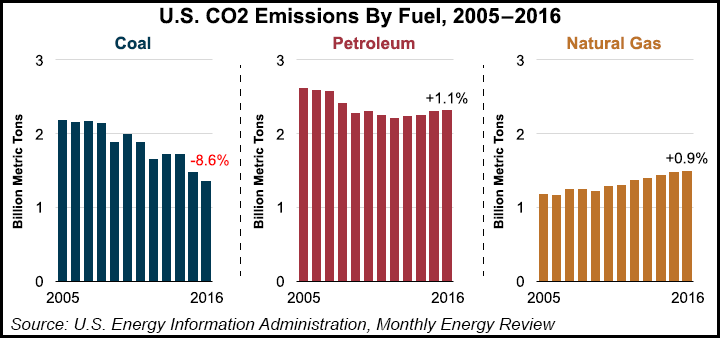Regulatory | NGI All News Access | NGI The Weekly Gas Market Report
NatGas, Oil Consumption Up As U.S. Energy-Related CO2 Drops 1.7% in 2016, EIA Says
Growth in natural gas-fired power generation was part of an overall reduction in U.S. energy-related carbon dioxide (CO2) emissions in 2016, the Energy Information Administration (EIA) said in a Monday note.

For 2016, U.S. energy-related CO2 emissions totaled 5,170 million metric tons, a 1.7% reduction from 2015 levels, EIA said. Before that, CO2 emissions had dropped 2.7% from 2014 to 2015.
“These recent decreases are consistent with a decade-long trend, with energy-related CO2 emissions 14% below the 2005 level in 2016,” the agency said.
The decrease in overall energy-related CO2 emissions came as consumption of both oil and natural gas increased, and as coal consumption decreased “significantly,” EIA wrote. Emissions levels also changed based on shifts in consumption, as natural gas CO2 emissions increased 0.9% and petroleum CO2 increased 1.1%, while coal-related CO2 declined 8.6%.
Overall carbon intensity decreased in 2016 as the U.S. economy grew, EIA said.
“Early estimates indicate that gross domestic product grew at a rate of 1.6% in 2016, down from 2.6% in 2015. Taken together with a 1.7% decline in energy-related CO2, the 1.6% estimate of economic growth implies a 3.3% decline in the carbon intensity of the U.S. economy,” EIA said. “In 2015, carbon intensity of the economy had decreased by 5.3%.”
In 2016, CO2 from transportation surpassed CO2 from the power sector, a trend EIA expects to continue in the decades ahead.
“CO2 emissions from the electric power sector fell by 4.9% in 2016” amid “a significant reduction in coal use for electricity” in favor of natural gas and renewables. With the increase in renewables and the lower emissions from gas-fired power plants, “data indicate about a 5% decline in the carbon intensity of the power sector, a rate that was also realized in 2015. Since 1973, no two consecutive years have seen a decline of this magnitude, and only one other year (2009) has seen a similar decline.”
EIA said weather played a role in 2016 CO2 emissions as well, with preliminary data indicating 10% fewer energy-intensive heating degree days and a 13% more cooling degree days compared to the norm.
“Heating degree days in 2016 were the second fewest of any year since at least 1949, consistent with relatively warmer winter months,” EIA said.
The recent declines in U.S. energy-related CO2 emissions come as the oil and gas industry pushes back against “keep it in the ground” activism. The American Petroleum Institute published a report last week that found anti-fossil fuel policies could result in millions of jobs lost by 2040.
© 2024 Natural Gas Intelligence. All rights reserved.
ISSN © 1532-1231 | ISSN © 2577-9877 | ISSN © 1532-1266 |
